Top 10 Patterns from Lake Havasu
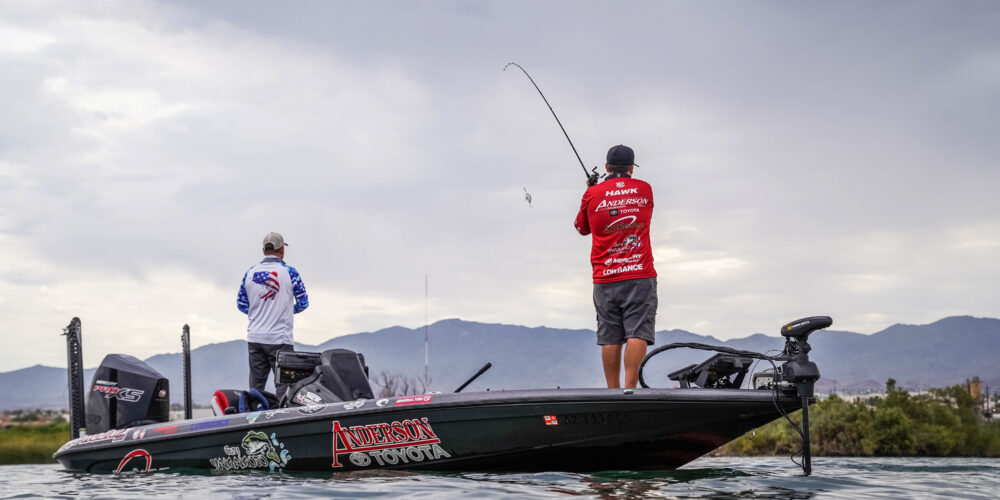
There were plenty of unknowns and plenty of optimism about Lake Havasu. All of it held true.
Being the first fall event on the fishery for the Toyota Series Presented by A.R.E. Western Division, the season finale served as an interesting test case about how the lake could show out, or if it would, during this time of year. Considering it took almost 20 pounds a day by Andrew Loberg to win, it definitely showed out … for some.
Many anglers struggled mightily, with limits being hard to come by for more than half the field. Yet, the Top 10 found plenty of success, especially those who opted to crank deep grass, while some shallow anglers came to play, too.
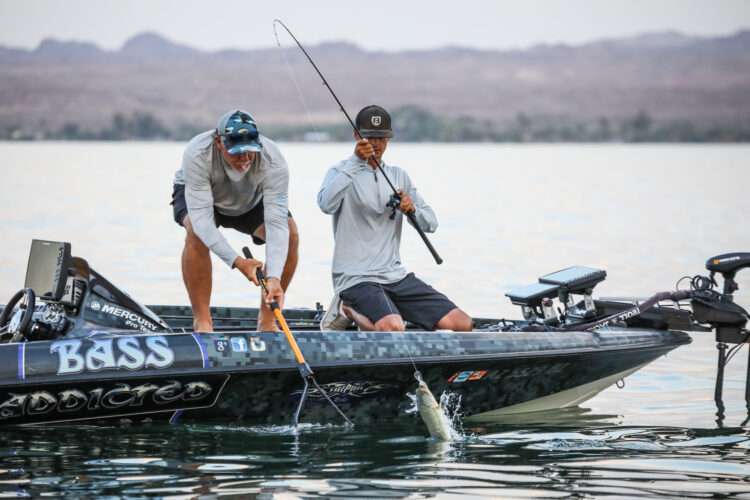
2. Mike Williams Cranks Close
Mike Williams came in with one goal: to win. And in probably any other tournament, he would’ve. Unfortunately for him, Andrew Loberg was doing the same thing as he was in a spot all to himself, and that might’ve made all the difference.
Just like Loberg, Mike Williams committed himself to putting a crankbait in his hands and not letting it go, doing everything he could to get reaction bites from fish in deep grass.
Yet, while Loberg had his sweet spots away from other anglers and even pleasure boaters, Mike Williams dedicated most of his time fishing within sight of or even within trolling motor distance of takeoff. And he certainly wasn’t there by himself, as third-place finisher Roy Hawk also started in the area, and even Mike’s brother, Mark, spent time there, among numerous other pros. And there was obviously plenty of fish there, as both Williams and his co-angler, eventual winner Kevin Gross, cracked over 17 pounds on Day 2.
“It’s just one of the best grass spots in the lake,” says Mike Williams of the area around takeoff. “It has man-made stuff, too, and it’s just an area they always get on this time of year.”
Now, he did have roughly eight spots with either weeds or man-made structures and would rotate them, which was key because he was never quite sure when a school would fire up.
On the first day, he didn’t get a bite for three hours before catching 5-, 4- and 3-pounders on consecutive casts to get things rolling. On Day 2, he had a limit within the first hour.
“I never know the timing here,” says Mike Williams. “And really, the bites came from everywhere. Once the sun got up high, the 13-19 foot range was usually where I got my bites, but I got my biggest bites on Day 1 in 8 feet of water.
“And it didn’t matter if it was man-made structure or grass. I caught 75 percent of my fish from just grass and 25 percent come out structure. I just had to keep hitting my spots.”
Regardless of where, he threw an array of crankbaits, including a SPRO Little John DD 70 (natural herring), Strike King 6XD (green gizzard shad) and Duo Realis G87 20A (Morning Dawn).

3. Hawk Starts, Stays in Third
Apparently, third place suited Roy Hawk this derby.
He was there after both days 1 and 2, but come the final day, many had pegged him as the one who was going to win. They felt he was playing opossum and was going to drop his biggest bag on Day 3 to pull off the comeback. After all, the Bass Pro Tour local had done it before.
Sure enough, those thinking that way were right about him dropping his biggest bag. Yet, it still wasn’t enough to pull off the shocker. Loberg’s final day bag was bigger, and he had to settle for third.
Obviously, not a bad finish, especially considering he was doing the same thing as both Loberg and Williams – cranking deep grass for a reaction bite. However, he did have a couple twists.
The first was what he was specifically cranking.
“Structure mixed with grass,” says Hawk. “Those were the best spots. There’s tons of structure around, but I needed good quality grass mixed in with the habitat. Didn’t matter where it was, but it had to have the mixture anywhere from 5 to 20 feet.”
Sometimes he’d cast at the structures, especially once the sun got up, but in the mornings he said he could cast around it, as the fish were swimming around and just relating to it.
The other wrinkle is that while he used a ton of different crankbaits, especially a Duo Realis G87 20A (Morning Dawn), it was a discontinued Yamamoto worm that accounted for some of his biggest bites all week. He’d toss it into any man-made structure he felt was still holding fish and was able to coax out so key bites to keep him in contention.
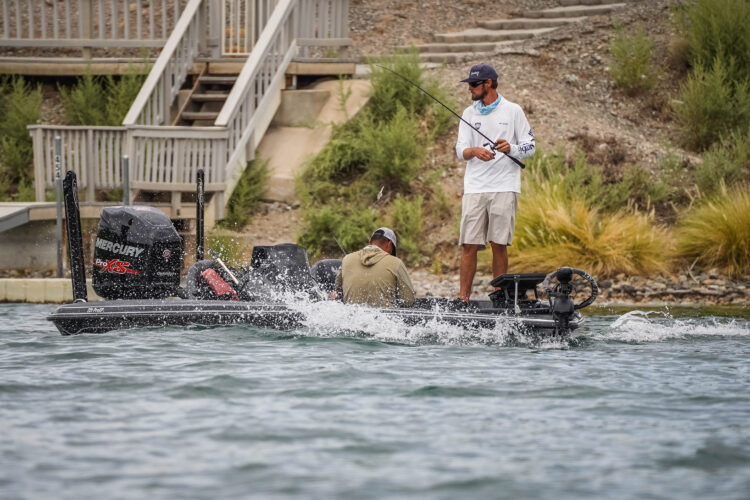
4. Younger Williams Holds Own
While older brother Mike got the headlines, especially after leading Day 1, younger brother Mark was no slouch this week. Though, he admits he felt he was going to do better.
“Fishing was tougher than I thought it’d be,” says Mark Williams. “Going into the tournament, I thought I was going to do really well, and I don’t know what happened. I was struggling so much I was worried I wouldn’t even catch five the final day.”
His “struggles” aside, Mark Williams did plenty well fishing a little ways away from his brother in the same grass flat near takeoff, though he did expand it a bit further south than his brother or Hawk.
Like them, he stuck with ripping various crankbaits, getting the most love from a Lucky Craft Flat CB D20 (chartreuse shad), but the biggest key was obviously the area that propelled three top-five anglers.
“[The grass] just grows here better,” says Mark Williams of that key area. “I don’t even know what kind of grass it is; some spiny, weird stuff, but they love it and will just come around here certain times of year.”

5. Mueller Ran Far up the River
Banking on the river is a tough go on Havasu. Not only are the fish typically a bit smaller than in the main lake, but they also tend not to replenish, making it tough to contend in a multiple-day event.
Don’t tell that to Frankie Mueller, though.
Growing up on Havasu and predominantly fishing the river, he knew where he was going, especially when he saw the water levels.
“The first day of the tournament, the water was low,” says Mueller, who opted to fish from an aluminum boat to get into the backwaters. “Yet, as the water came up I knew those fish would move further into the tulles. So, I’d pull into the best tulle patches I know and either cast a frog or flipped a Missile Baits D Bomb (green pumpkin blue) or Zoom Speed Craw.
“If you could get a bite and get it out of there, it was a good one.”
And Mueller truly was getting his baits deep into the tulles, even the red-and-black River2Sea Ish Monroe Phat Mat Daddy Frog, much further back than most. Then again, he also traveled further than most, too, sometimes running up the river as far as Needles (roughly 30 miles upstream). Though, he didn’t need to go that far the final day, seeing his areas close to the mouth of the river were producing better with the higher water.
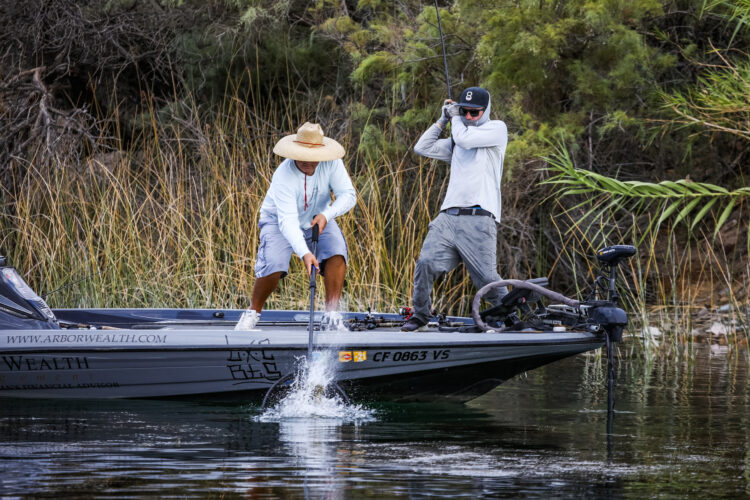
6. Dutra Caps AOY Season
Look out Tackle Warehouse Pro Circuit. Phillip Dutra is coming.
Fishing his first full Toyota Series Presented by A.R.E. Western Division season, the California pro put together a pair of top-5 finishes in the first two events. So, coming into Havasu, he had three goals:
“By far, my No. 1 goal was to finish in the top five in points to qualify for the Tackle Warehouse Pro Circuit next year,” says Dutra, who is planning on moving to Alabama to pursue the dream. “Second was to close out Angler of the Year and the third was to make the Top 10. And I accomplished all three. So, beyond stoked right now.”
He accomplished this by working his way up the California side of the river. There’s a seemingly endless supply of tiny pockets rimmed with tulles and loaded with matted vegetation, and every day, Dutra simply worked his way through each of them.
“It was a frickin’ grind,” says Dutra. “I flipped so many patches. It was not easy.”
Obviously, flipping crayfish-colored Missile Baits D Bombs was his main pattern, but he also caught some good fish on a Snag Proof Bobby’s Perfect Frog, a Z-Man Evergreen ChatterBait JackHammer and mixed in a squarebill.
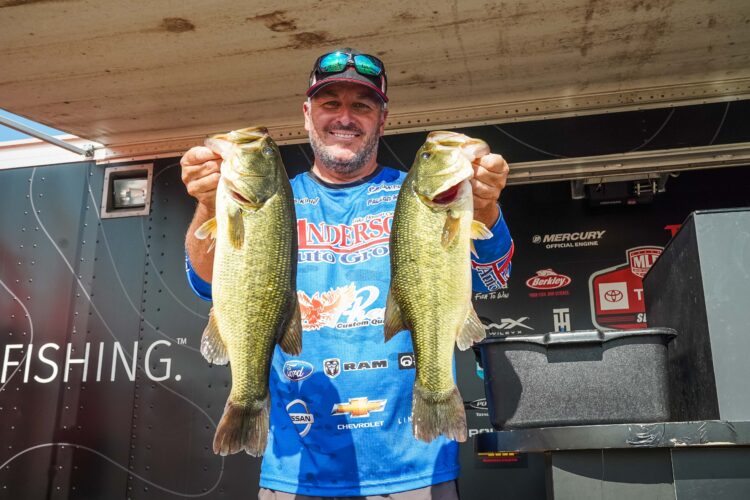
7. Kinley’s Stealth Key with Little Practice
Chris Kinley has plenty of experience on Havasu. Hence, why he wasn’t too concerned about a lack of practice.
“I had no practice,” says Kinley, who made his third Top 10 on Havasu in Toyota Series competition. “I had been elk hunting for two weeks. So, I got home Tuesday night, and I had a chance to practice for three hours Wednesday morning. Literally just ran up and down the lake, burned some gas. Stopped here, stopped there.
“So, I spent the entire tournament fishing in a crowd in the Bill Williams Arm.”
With so much fishing pressure down there, Kinley says he had to “be a ninja in the crowd,” often sliding in after anglers had left, and he had to be meticulous and extra quiet with his casts.
“If you could really be quiet, you’d get bit,” says Kinley.
As for what he was fishing, it was all grass and tulles with a green pumpkin-purple tube made by fellow Top 10 angler Frankie Mueller or a shad-colored 3/8-ounce homemade vibrating jig.

8. Kodama Gets Aggressive with Finesse
Hailing from Japan, Kazuki Kodama is no stranger to pressured fish and finesse tactics. So, that experience and skill got put to work on Havasu.
Making a long run down lake, he was targeting shallow grass in 3-4 feet. However, so were plenty of other pros down there. That’s where a unique technique with a common rig gave him the edge.
“I was using a Zoom Swamp Crawler (June bug) on a Neko rig with a 5/64 weight and 6-pound Sunline,” says Kodama. “But I was popping it hard.”
Basically, much like how the crankbait guys were getting reaction bites, so was Kodama. He’d make extra-long casts – something he said was imperative with the pressure making the fish “nervous” – and then aggressively twitching and popping the rig in and above the weeds to get the fish to react.
While he never got any kicker bites with the trick, it got him plenty of bites to secure the Top 10.

9. McAbee Jr. Runs Precise Points
There’s keying on something specific, and then there’s what Randy McAbee Jr. was doing.
One of the few pros down south of takeoff about midway to the dam, McAbee did a ton of graphing in practice looking for points. Actually, not just points, but very specific ones.
“The point had to be halfway back in the coves,” says McAbee. “Nothing main lake. It had to be pretty steep, with a mixture of rock and grass outside it. And it had to give shade on the north side.”
Fortunately, the Arizona side of Havasu is loaded with just that precise combination, as McAbee set up a milk run of 50 of them, hitting all of them on the way down and as many as he could on the way back.
Of course, to hit that many spots he had to fish fast, which he did “grinding the lip” off a Strike King 5XD in perch, shad or crawdad colors – “Whatever felt good at the time.”
“The fish were in the shade, and when that hot sun got up I was just cranking the shade lines,” says McAbee. “I’d make about 10 casts and I was gone.”
Unfortunately, he couldn’t get those fish to bite the crankbait until that sun came up, meaning most mornings he went hours before his first bite. The final day, with clouds throughout the day, he opted to start with a buzzbait and caught two, but that’s all he got.
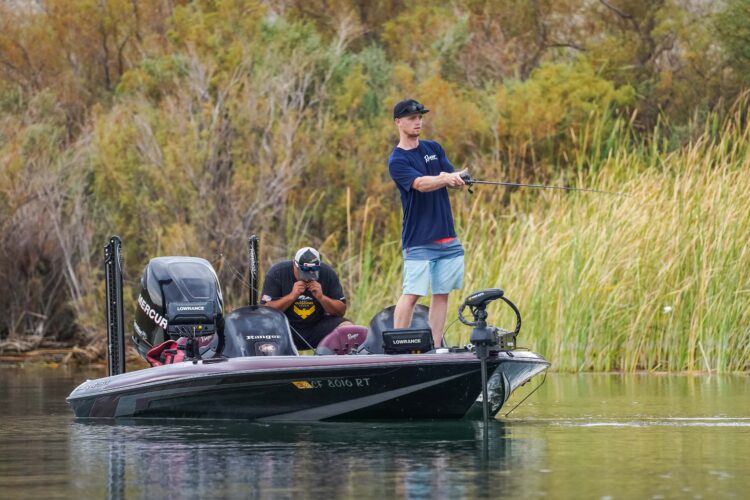
10. Huntze Junks to Success
What are you to do when you have zero experience on a lake and in prefishing, every day was different?
If you’re Logan Huntze, you junk fish. A lot.
“I was doing it all – drop-shot, topwater, reaction, deep crank, flipping a little bit,” says Huntze, who won the first Western Division event of the season on the California Delta. “I was running the whole lake and doing different things. Just fishing a bunch of different stuff different ways.”
That’s junk fishing at its finest.
Of his vast arsenal of lures, he says cranking a shad-colored Strike King 6XD or 6th Sense Cloud 9 Series did the most damage and flipping a Missile Baits D Bomb (candy grass) produced some quality bites.
Unfortunately, he lost a giant on Day 2 and only brought in four fish, which hurt any chances of him contending for the win, and his pattern completely fizzled by the final day, bringing in only three fish.